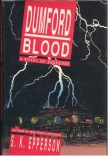Dumford Blood
S. K. Epperson
Saint Martin's Press
US Hardcover First
ISBN 0-312-06342-3
296 pages; $18.95
Date Reviewed: 02-28-92
Reviewed by Rick Kleffel © 1992

REFERENCES
|
|
|
Dumford BloodS. K. EppersonSaint Martin's PressUS Hardcover FirstISBN 0-312-06342-3296 pages; $18.95Date Reviewed: 02-28-92Reviewed by Rick Kleffel © 1992 |
|
|
REFERENCES |
|
I guess it happened while I was at work, or, of course, while I was reading. But somehow, sometime, it seems most of the nation's population moved out of cities and suburbs, moved out of ill-defined, nebulous areas of habitation and into rigidly marked, sign-on-the-dotted-line small towns. Population three figures and staying there. The only ones left in the big cities must be horror fiction readers. We know what goes on in small towns, don't we?
Well, for those who don't, S. K. Epperson will give you a pretty good, though generic, idea of what happens to those who live in a small town. You die, unnaturally. In the opening pages of "Dumford Blood", Epperson creates a very small town that could be called Stephen King-ville and then proceeds to populate that town with obnoxious gossips, wife beaters, brainless gold-diggers and other, less likeable types.
The first half of the book builds these characters extremely well, and despite the fact that most of them are despicable, it's still a pretty compelling read. Ben Portlock is the nominal good guy cop, who gave the testimony that sent his old girlfirend, Lura, to jail eight years ago. Now she's back, helping her brother Philip take care of their looney-tunes mother, Annette. Ben's sister, Edie, is pregnant and married to the richest man in town, Portis Jackson. Unfortunately for her, it's not his kid. Hannah is the the prototypic old-maid schoolteacher, now a police dispatcher who sticks her nose into everybody's business and is certainly not above a little social engineering through selective distribution of edited versions of the truth. And finally, we have somebody in town who's got something against pregnant animals, and is not above leaving emptied-out corpses in scenic, well-described positions. Epperson does an admirable job of setting up the tensions and conflicts amongst his small cast of characters, each of whom is clearly portrayed. In the second half of the book, the conflicts are resolved in a tense climax.
What's missing from "Dumford Blood" is Dumford, Kansas. There's an excellent sense of character and almost no sense of place; Dumford Kansas could as well be Orange County, California. The descriptions of the town are generic at best, and the characters we meet, while they are clearly portrayed, could come from anywhere. The local industry is only vaguely mentioned, and once the opening paragraphs pass, we're given no regional feel, in the way, say, that Joe R. Lansdale does Texas, Flannery O'Conner, the deep south, or Ruth Rendell, suburban England. "Dumford Blood" is a fast, bland, exciting read by a regional author (Epperson does live in Kansas), who seems to take her region for granted.